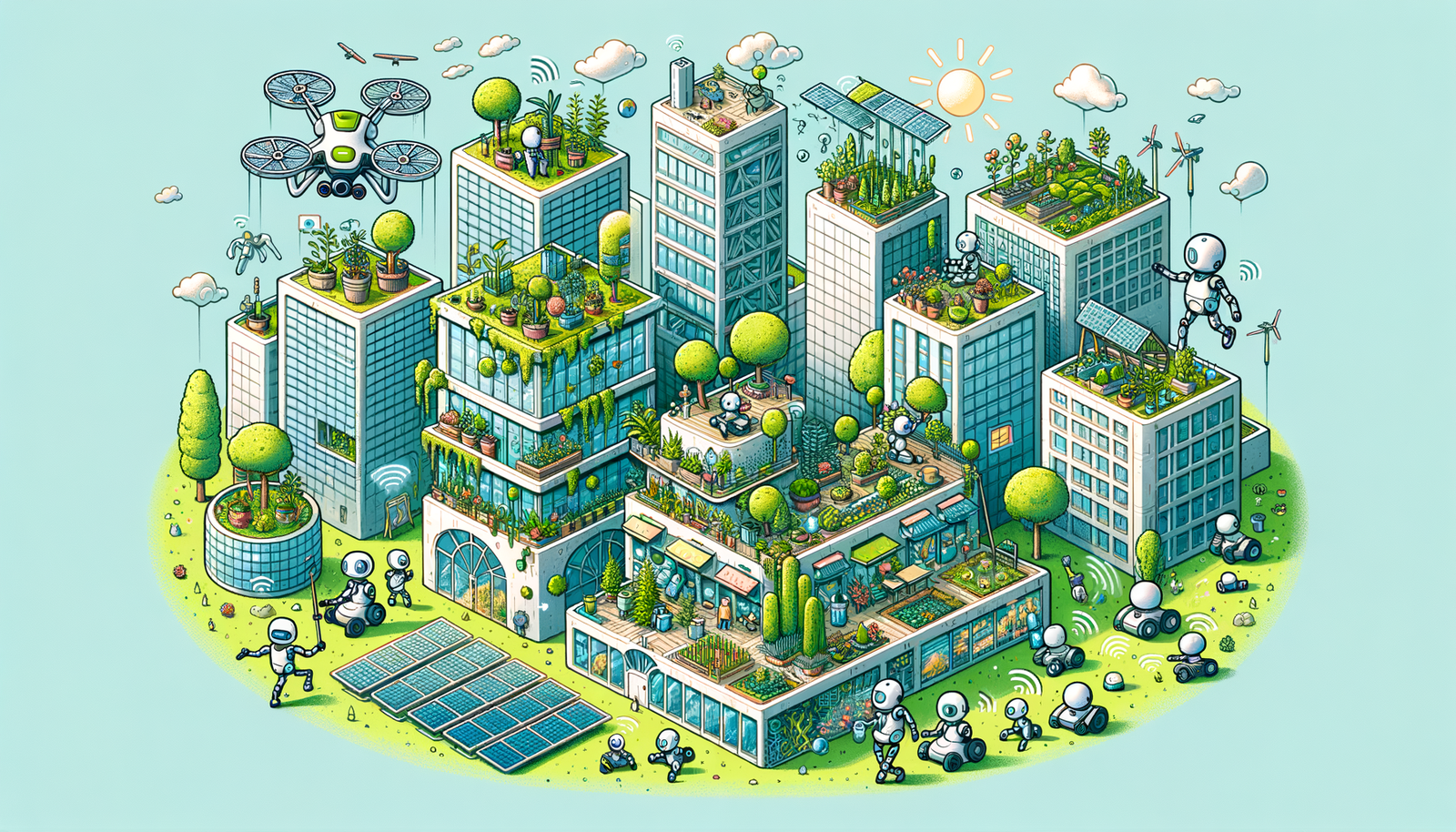Your Cart is Empty
Customer Testimonials
-
"Great customer service. The folks at Novedge were super helpful in navigating a somewhat complicated order including software upgrades and serial numbers in various stages of inactivity. They were friendly and helpful throughout the process.."
Ruben Ruckmark
"Quick & very helpful. We have been using Novedge for years and are very happy with their quick service when we need to make a purchase and excellent support resolving any issues."
Will Woodson
"Scott is the best. He reminds me about subscriptions dates, guides me in the correct direction for updates. He always responds promptly to me. He is literally the reason I continue to work with Novedge and will do so in the future."
Edward Mchugh
"Calvin Lok is “the man”. After my purchase of Sketchup 2021, he called me and provided step-by-step instructions to ease me through difficulties I was having with the setup of my new software."
Mike Borzage
Harnessing Artificial Intelligence for Sustainable Urban Landscape Design
November 07, 2024 8 min read


Landscape design is a critical component of urban planning and environmental conservation, serving as the bridge between natural ecosystems and human-made environments. It shapes the spaces where people live, work, and recreate, influencing not only the aesthetic appeal but also the ecological health and functionality of urban areas. As cities continue to grow and the pressures on natural resources intensify, the need for sustainable landscape practices has become more pronounced. Traditional methods of landscape design often struggle to keep pace with the complexities of modern environmental challenges such as climate change, biodiversity loss, and resource scarcity. This is where artificial intelligence (AI) comes into play, offering innovative solutions to enhance design practices. AI technologies bring advanced capabilities in data analysis, predictive modeling, and automation, enabling landscape architects to create designs that are both aesthetically pleasing and ecologically responsible. By integrating AI tools, designers can better understand complex environmental data, predict the outcomes of their designs, and optimize sustainability. The focus of this article is to explore specific AI tools that promote sustainability and efficiency in landscape planning, highlighting how these technologies are transforming the field and contributing to the creation of resilient urban ecosystems.
Understanding AI in Landscape Design
Artificial intelligence is a branch of computer science that aims to create systems capable of performing tasks that typically require human intelligence. In the realm of landscape design, AI encompasses technologies such as machine learning algorithms, neural networks, and advanced data analytics. These technologies are particularly relevant because they can process and interpret vast amounts of complex environmental data, which is essential for informed decision-making in landscape architecture. AI's primary components in this context include data collection, pattern recognition, predictive modeling, and automated reasoning. By leveraging these components, AI systems can analyze variables such as climate, topography, soil conditions, hydrology, and biodiversity to provide insights that are beyond the capacity of traditional analysis methods.
One of the significant advantages of AI in landscape design is its ability to analyze environmental data and predict outcomes with a high degree of accuracy. For instance, AI algorithms can process historical climate data to forecast future weather patterns, enabling designers to select plant species that will thrive under changing conditions. AI can also assess soil composition and predict erosion risks, allowing for the implementation of preventative measures in the design phase. Moreover, AI systems can model water flow and drainage patterns, which is crucial for flood prevention and water conservation strategies. By utilizing AI for these purposes, landscape architects can design spaces that are not only visually appealing but also sustainable and resilient to environmental changes.
There are several practical applications of AI tailored to landscape design. Site analysis and suitability modeling are among the most prevalent uses. AI tools can evaluate multiple factors simultaneously to determine the most suitable use for a particular land area. This includes analyzing proximity to natural resources, assessing environmental constraints, and identifying opportunities for ecological enhancement. By integrating various data layers, AI can suggest optimal layouts that preserve sensitive areas, enhance connectivity, and maximize ecosystem services. Another application is design generation using machine learning algorithms. AI can generate multiple design iterations based on specific parameters, such as sustainability goals, aesthetic preferences, and regulatory requirements, thereby accelerating the design process and fostering innovation. These algorithms can learn from previous designs, adapt to new information, and even propose unconventional solutions that human designers might not consider. Additionally, AI provides real-time feedback on design performance. As designers make changes to a project, AI can instantly analyze the potential impacts on energy efficiency, water usage, and ecological connectivity, allowing for immediate adjustments to improve sustainability outcomes. This dynamic interaction between the designer and AI tools enhances the decision-making process and leads to more refined and effective landscape designs.
Key AI Tools and Technologies
Several AI tools and technologies are redefining the landscape design process by enhancing capabilities and introducing new methodologies. One of the most influential tools is Geographic Information Systems (GIS) integrated with AI. GIS is a framework for gathering, managing, and analyzing spatial and geographic data. When combined with AI, GIS becomes a powerful tool for spatial analysis, enabling designers to understand spatial patterns and relationships more deeply. This integration allows for the analysis of environmental variables such as land use patterns, habitat connectivity, and resource distribution, which are crucial for sustainable planning. By applying AI algorithms to GIS data, designers can perform complex analyses such as predictive modeling of urban growth, optimization of green spaces, and identification of areas most susceptible to environmental risks.
Parametric design tools that respond to ecological data inputs represent another significant advancement. These tools use algorithms to manipulate design parameters and automatically adjust models based on environmental data. For example, a parametric tool might adjust the orientation of a landscape feature to maximize sunlight exposure for vegetation or optimize pathways to minimize soil compaction. This approach allows for a more flexible and responsive design process, where changes in environmental input data lead to immediate adjustments in the design output, ensuring that the final design remains aligned with sustainability objectives. Parametric tools enable the exploration of a wide range of design options, facilitating creativity while grounding design choices in ecological realities.
AI-driven simulation environments for visualizing and testing landscape designs offer an immersive experience for designers and stakeholders. These simulations can model various environmental scenarios, such as the growth of vegetation over time, seasonal changes, or the impact of extreme weather events. By visualizing these scenarios, designers can anticipate potential issues and make proactive adjustments. Simulations can also assess human interactions with the landscape, such as pedestrian flow or usage patterns, which are essential for creating functional and user-friendly spaces. The ability to test and refine designs in a virtual environment reduces the risk of costly mistakes and enhances the overall quality of the final project.
The benefits of using these AI tools in landscape design include:
- Improved decision-making through comprehensive data analysis, allowing for designs that are both functional and sustainable.
- Enhanced sustainability by identifying the most ecologically beneficial design options, promoting biodiversity and resource conservation.
- Increased efficiency by automating time-consuming calculations and simulations, freeing up time for creative exploration.
- Greater innovation potential through the exploration of unconventional design solutions, pushing the boundaries of traditional landscape architecture.
- Enhanced stakeholder engagement by providing clear visualizations, facilitating better communication and collaboration.
Sustainable Planning Practices Enabled by AI
AI plays a crucial role in enabling sustainable planning practices within landscape architecture by providing tools that support precise and informed decision-making. One of the key contributions is in water management through predictive analytics. AI can analyze data related to rainfall patterns, soil permeability, and topography to predict water flow and accumulation areas. This information allows designers to implement strategies such as bioswales, rain gardens, and permeable surfaces to manage runoff effectively, reduce flooding risks, and promote groundwater recharge. By optimizing water management, landscapes not only become more resilient to climate variability but also contribute to the overall health of urban ecosystems. Effective water management is essential for maintaining vegetation health, supporting biodiversity, and ensuring the long-term sustainability of urban green spaces.
Another significant area is biodiversity assessments facilitated by AI data processing. Biodiversity is a vital component of sustainable landscapes, providing ecological services such as pollination, pest control, and habitat for wildlife. AI can process large datasets on species distribution, habitat requirements, and ecological interactions to inform planting strategies that enhance biodiversity. For example, AI can help identify native plant species that support local pollinator populations or suggest plant combinations that promote ecological synergy. By incorporating biodiversity considerations into the design process, landscapes become more robust and capable of supporting a wider range of ecological functions. This not only benefits the environment but also enhances the aesthetic and experiential qualities of the landscape for human users.
AI also aids in carbon footprint reduction via optimized planting strategies. Vegetation plays a significant role in sequestering carbon dioxide from the atmosphere, and the choice of plant species and layout can influence the effectiveness of this process. AI can model the carbon sequestration potential of different plant species over time, considering factors such as growth rates, biomass accumulation, and lifespan. This enables designers to select species that maximize carbon uptake and contribute to climate change mitigation efforts. Additionally, AI can optimize planting layouts to enhance photosynthetic efficiency and reduce urban heat island effects, further supporting sustainability goals. By strategically designing planting schemes, landscapes can become active participants in reducing greenhouse gas concentrations and mitigating local climate impacts.
Despite the numerous advantages, there are challenges and limitations to using AI in sustainability efforts within landscape design. One of the primary challenges is data quality and availability. Effective AI analysis depends on high-quality, comprehensive datasets. In many cases, relevant environmental data may be incomplete, outdated, or inaccessible, which can compromise the accuracy of AI predictions and recommendations. Efforts to standardize data collection and improve data-sharing practices are necessary to overcome this barrier. Collaborative initiatives between government agencies, research institutions, and private organizations can help in building robust databases that benefit the entire industry.
Another significant limitation is the requirement for interdisciplinary collaboration. The successful integration of AI into landscape design necessitates collaboration between landscape architects, data scientists, ecologists, urban planners, and other specialists. Each discipline brings unique expertise that is essential for the holistic application of AI tools. However, facilitating such collaboration can be challenging due to differences in terminology, methodologies, and priorities. Developing interdisciplinary communication skills and fostering collaborative environments are essential steps in addressing this challenge. Educational programs and professional development opportunities that promote cross-disciplinary understanding can also play a crucial role in bridging gaps between fields.
Additional challenges include:
- Accessibility of AI tools: High costs and technical complexity can limit the adoption of AI technologies by smaller firms or individual practitioners.
- Ethical considerations: Concerns about data privacy, transparency in AI decision-making processes, and potential biases in algorithms must be addressed to ensure responsible use.
- Resistance to change: Traditional practices and skepticism towards new technologies can hinder the integration of AI in the industry.
Conclusion
The transformative impact of artificial intelligence on landscape design is evident in the enhanced capabilities for sustainability and efficiency. AI technologies provide landscape architects with powerful tools to analyze complex environmental data, predict outcomes, and create designs that are responsive to both human needs and ecological imperatives. By embracing AI, designers can move beyond traditional practices to develop innovative solutions that address the pressing environmental challenges of our time. The future prospects for AI innovations in landscape architecture are promising, with potential developments in areas such as autonomous maintenance systems, real-time environmental monitoring, and advanced modeling techniques. These advancements could further enhance the ability of landscape architects to create sustainable, resilient, and adaptive environments. A call for further integration of AI in landscape practices is essential to foster smarter, greener, and more resilient environments that can sustain both current and future generations. By investing in AI technologies and fostering interdisciplinary collaboration, the landscape architecture profession can lead the way in creating sustainable solutions that harmonize the built and natural environments.
Also in Design News

Design Software History: APT to G‑Code Dialects: The Evolution and Persistence of Vendor‑Specific CNC Post‑Processing
January 06, 2026 11 min read
Read More
Real-time CFD for Design Reviews: Progressive Solvers, GPU Pipelines, and Uncertainty-Aware Collaboration
January 06, 2026 12 min read
Read More
Cinema 4D Tip: Weight Manager Workflow for Fast, Stable Character Skinning
January 06, 2026 2 min read
Read MoreSubscribe
Sign up to get the latest on sales, new releases and more …


